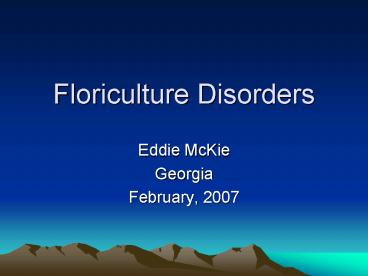Floriculture Disorders PowerPoint PPT Presentation
1 / 23
Title: Floriculture Disorders
1
Floriculture Disorders
- Eddie McKie
- Georgia
- February, 2007
2
APHIDS
- Small (up to ¼) soft-bodied insects.
- The characteristic feature that distinguishes
aphids from other insects are the tail pipes
(called cornicles) which extend from the rear of
their abdomen.
3
FUNGUS GNATS
- Adult fungus gnats are about 1/8 to 1/10 inch
(2.5 mm) long, grayish to black, slender,
mosquito-like, and delicate with long legs,
antennae and one pair of wings.
4
LEAF MINER
- Insect larvae that feed inside a leaf, between
the upper and lower surfaces.
5
MEALY BUG
- Mealybugs derive their name from the white, waxy,
mealy secretions that cover their bodies.
6
SCALE
- Either soft scales or armored scales
- Covered with waxy shell for most of their life
which protects them from predators or insecticides
7
SLUG
- Slugs are gastropod mollusks without shells or
with very small internal shells, in contrast to
snails.
8
SPIDER MITE
- To the naked eye, spider mites look like tiny
moving dots - Adults have eight legs and an oval body, with two
red eyespots near the head end of the body.
9
POWDERY MILDEW
- Infected plants will display white powder-like
spots on the leaves and stems. - The fungus is favored by periods of high relative
humidity or site conditions that promote a more
humid environment
10
THRIP
- Thrips are small (1/8 long) and narrow-bodied
insects commonly found feeding on leaves and
stems. - The presence of thrips gives a splotchy
appearance to leaves.
11
WHITEFLY
- Adults are less than 1/8 long and, like their
name suggests, have white wings with pale yellow
bodies. - Adult whiteflies congregate above and under leaf
surfaces, and disperse in clouds when disturbed.
12
BLACKLEG
- Plants with blackleg are stunted and have a
stiff, erect growth habit. - Foliage becomes chlorotic and the leaflets tend
to roll upward at the margins. - Stems of infected plants exhibit an inky black
decay. The base of the stem is often completely
rotted. - In relatively dry soil, only the pith may show
blackening.
13
BLACK SPOT
- Round to irregular black splotches with fringed
margins are quite obvious, mostly on upper leaf
surfaces. - Round to irregular black splotches with fringed
margins are quite obvious, mostly on upper leaf
surfaces. Leaf yellowing develops around these
black spots, with defoliation of these infected
leaves common. Round to irregular black splotches
with fringed margins are quite obvious, mostly on
upper leaf surfaces. Leaf yellowing develops
around these black spots, with defoliation of
these infected leaves common. Leaf yellowing
develops around these black spots, with
defoliation of these infected leaves common.
14
BOTRYTIS
- Botrytis is by far the most common fungal disease
encountered under cool, humid conditions,
particularly were crops are grown at a high
density with limited air movement.
15
DAMPING OFF
- A common fungal disease that attacks seedlings,
weakening the stems right at the soil level.
Infected seedlings usually die.
16
MOSAIC VIRUS
- Characterized by the presence of intermingled
patches of normal and light green or yellowish
colored plant tissue.
17
ODEMA
- appears as small, sometimes corky blisters which
form on the lower surface of leaves or needles. - These blisters may eventually harden to form
white, tan, or brown wartlike corky bumps on the
lower leaf surface.
18
COLD WATER DAMAGE
- Often begins with halo spots of the leaves
caused by overhead watering with cold or cool
water.
19
IRON CHLOROSIS
- Iron chlorosis is a yellowing of plant leaves
caused by iron deficiency that affects many
desirable landscape. - The primary symptom of iron deficiency is
interveinal chlorosis, the development of a
yellow leaf with a network of dark green veins.
20
BERMUDAGRASS
- Bermudagrass is creeping perennial warm-season
grass. Bermudagrass spreads by both rhizomes and
stolons. - The leaves of bermudagrass are folded in the
bud, and the sheath is strongly compressed. - The leaf is short, approximately 1/8 inch wide
with rough edges. - The roots of bermudagrass are deep and fibrous
allowing it to be highly drought tolerant. - The stolons root at the nodes forming a thick
dense mat. - The seedhead of Bermudagrass consists of 3 - 7
finger-like spikes. - Common bermudagrass can spread by seed.
21
CRABGRASS
- Crabgras is a low-growing summer annual that
spreads by seed and from rootings of nodes that
lie on the soil. - It may grow upright to a height of 2 feet. It
will not tolerate close mowing as well as smooth
crabgrass. - True leaves are generally 3 inches long and hairy
on the upper surface of the leaf and leaf sheath.
- The branches are l about 2 to 5 inches at the end
of the stalk.
22
NUTGRASS
- Nutgrass has yellow-green, wide-bladed leaves
that are smooth and shiny or waxy on the upper
side. - Nutgrass grows 1-3 feet tall if not mowed.
- Yellow and purple varieties
23
OXALIS
- The leaves are divided into three to ten or more
round, heart-shaped or lanceolate leaflets,
arranged in a whorl with all the leaflets of
roughly equal size. - The majority of species have three leaflets in
these species, the leaves are superficially
similar to those of some clovers

